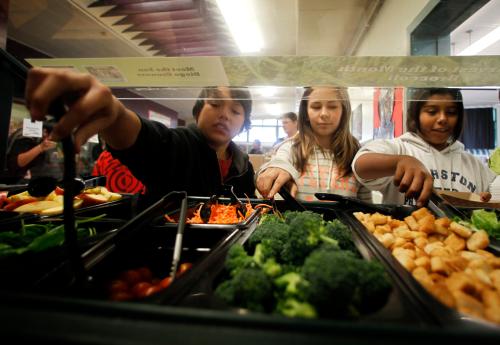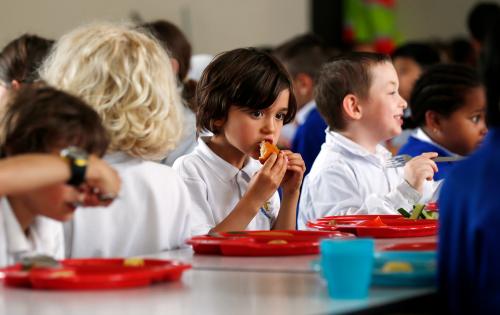School lunch is one of the most stable features of a child’s school day—and principals have more influence over this longstanding tradition than you might think. Each school day, students file into the cafeteria for lunch. Yet, the quality of this experience, along with the benefits it provides to students, varies from one school to the next, in no small part due to decisions and policies made by the school’s principal.
Principals are the CEOs of their school, governing everything fro
m academics and learning, to programming and extracurricular activities, to culture and community engagement. My research on the school meals program finds that principals also have influence over another, often lesser considered area of the school—the cafeteria.[1]
This finding is noteworthy not only because children spend a considerable amount of time in the school cafeteria but also because school meals have been shown to have an effect on students’ health and academic outcomes. Previous research by our team suggests school meal programs such as Universal Free Breakfast, Breakfast in the Classroom, and Water Jets (electronically-cooled tap water machines) are important for student outcomes. This work is part of a larger body of work on the effect of school meals on students’ academic outcomes, school attendance, nutrition, and weight. Given the importance of school meals, researchers and policymakers need to better understand how the quality of the school lunch experience is influenced and by whom.
School meals are governed by federal, state, and district-level regulations. These include national standards that mandate the nutritional content of meals and district-level policies that, for example, set the cost of meals or dictate the type of food allowed to be sold in vending machines. We find that discretion is often left to the school to carry out these programs, and some policies are even set by the schools themselves. As such, schools within the same district can have very different cafeteria environments, and these policies can even vary by grade within a school.
In New York City (NYC), for example, many schools supplement their traditional meals programs with salad bars or water jet machines in their cafeteria. Schools are responsible for setting the daily schedule, which dictates the timing and duration of breakfast and lunch periods. Some schools, for example, begin serving lunch as early as 10:30 a.m., and other schools finish serving lunch after 1:00 p.m. Lunch periods also range from 20 minutes to almost an hour. Schools typically set their own policies limiting “junk food” brought from home, and choose whether or not to offer à la carte sales or student vending machines. The result is a landscape—even within the same school district—in which children experience different meals programs.
Interestingly, principals play a key role in shaping the school food environment. Our study, based on data from roughly fifty hours of observation across eight NYC public schools and thirty interviews with school- and district-level staff, including principals, cafeteria managers, lunch coordinators, and district food executives, reveals that virtually all of these school-level differences in practice were decided by the school principal, which means principals are much more influential than researchers and policymakers have previously acknowledged.
Why does it matter that principals, rather than someone involved directly in food service or child wellness, set these policies? Principals may not be well versed in the importance of school meals for children, thus may make uninformed management decisions. For instance, very few principals in our study required students to go to the cafeteria in the morning before the start of school, which can encourage breakfast taking.
Alternatively, even if principals are fully aware of the benefits of these programs, they often have other competing priorities that dominate, and are focused on management efficiency, not necessarily student benefit. Apparent from our research is that principals, when making decisions that impact school meals, prioritize academics over the meals programs. Concerns about student safety and school cleanliness also weigh heavily in their decisions.
For instance, we found that some principals opted not to install water jets in the cafeteria, despite the benefit to student health, in order to avoid spilled water that could result in students slipping. As another example, very few principals set school policies to limit junk food brought from home. One principal in our study sample that did have such a policy, though, cited a concern about sanitation – spilled wrappers and crumbs. These findings suggest that principals are unaware of the benefits of school meals, or do not prioritize student health when making decisions about school food programs and policies.
Despite the potential link between school meals and other outcomes, the cafeteria is often viewed as distinct from the rest of the school. Our findings debunk this notion. Rather, principals have substantial influence over meal practices in schools. Furthermore, despite the importance of school breakfast and lunch, principals often prioritize academics, student safety, and school cleanliness over school meals, suggesting that principals may not be knowledgeable about the benefits of school meals, or may not have the capacity to promote a healthy school food environment. For instance, if principals set lunch too early, or do not schedule a long enough lunch period for all students to finish their meals, students may be hungry in the afternoon and less able to concentrate in classes later in the day.
As principals’ roles in the school continue to become increasingly more complex, it is wise to evaluate their influence over the school cafeteria, which certainly influences the learning, health and lifestyles of children. If principals continue to have such discretion over school meals, they must be encouraged to consider student health in addition to academics and other concerns. We might even question the principal’s oversized role in the lunchroom; it may be best to leave important school food decisions to the district-level food and nutrition experts, and put less of this burden on principals.
[1] This project, funded by the National Institutes of Health (PI: Amy Ellen Schwartz), was conducted with researchers from NYU Steinhardt, NYU School of Medicine and Syracuse University.






Commentary
Principal, not food experts, most influential in the school cafeteria
August 29, 2016